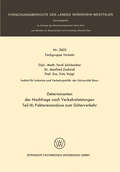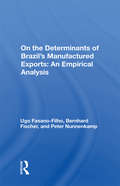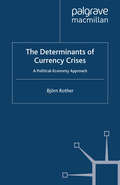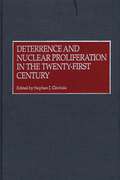- Table View
- List View
Determinanten der Nachfrage nach Verkehrsleistungen: Teil III: Faktorenanalyse zum Güterverkehr (Forschungsberichte des Landes Nordrhein-Westfalen #2603)
by Ferdi Solzbacher Manfred Zachcial Fritz VoigtDeterminanten der Nachfrage nach Verkehrsleistungen: Teil I: Personenverkehr (Forschungsberichte des Landes Nordrhein-Westfalen #2546)
by Fritz VoigtDeterminants Of Brazil's Manufactured Exports: An Empirical Analysis
by Ugo Fasano-FilhoThis study seeks to identify the determinants of Brazil's favourable export performance until the mid-1980s, especially in the field of manufactured goods. Two hypotheses figure prominently in the analysis. The export success may be due to Brazil's specialization in industries which made intensive use of the country's relatively abundant productive factors. Alternatively, economic policies may be responsible for the success in manufactured exports.
Determinants Of Brazil's Manufactured Exports: An Empirical Analysis
by Ugo Fasano-FilhoThis study seeks to identify the determinants of Brazil's favourable export performance until the mid-1980s, especially in the field of manufactured goods. Two hypotheses figure prominently in the analysis. The export success may be due to Brazil's specialization in industries which made intensive use of the country's relatively abundant productive factors. Alternatively, economic policies may be responsible for the success in manufactured exports.
The Determinants of Currency Crises: A Political-Economy Approach
by B. RotherThis book explores the role of political factors in the occurrence of currency crises, using an eclectic approach that blends case studies, a rigorous theoretical discussion, and econometric analysis.
The Determinants of Economic Growth
by N. Windt ThijsRuyter Van Steveninck M. S. OosterbaanDeterminants of economic growth: An overview Thijs de Ruyter van Steveninck, Nico van der Windt, and Maaike Oosterbaan Netherlands Economic Institute What causes economic growth? Why have some countries grown much faster than others? Why do some countries not grow at all, or even experience negative (per capita) growth rates? What can governments do to raise the growth rates of their country? These questions were discussed at a conference on March 23 and 24, 1998, organized by the Netherlands Economic Institute (NEI) on behalf of the Netherlands Ministry of Foreign Affairs. This book contains the proceedings of the conference. Economic growth is widely considered as a necessary (though not sufficient) condition for poverty alleviation. During the past two decades, scholars and researchers have found a renewed interest in thinking about economic growth, and advances in the understanding of economic growth have taken place. On the one hand, the theoretical understanding of growth has progressed on various fronts, including endogenous technological innovation and increasing returns to scale; the interaction of population, fertility, human capital, and growth; international spill-overs in technology and capital accumulation; and the role of institutions. On the other hand, the increasing availability and use of data sets has given a large incentive to empirical research on cross-country growth, following the path-breaking work ofBarro (1991).
Determinants of FDI Flows within Emerging Economies: A Case Study of Poland (Studies in Economic Transition)
by A. MironkoThis study provides a detailed examination of foreign direct investment (FDI) in Poland and explores the impact this has on foreign investment policy. It analyzes and identifies location patterns of FDI and strives to determine the supporting motives behind location choices of foreign companies.
Determinants of FDI in Central and Eastern Europe: The Effects of Integration into the European Union (Contributions to Economics)
by Hanna MakhavikovaThis book provides a detailed examination of foreign direct investment (FDI) inflows in Central and Eastern Europe (CEE) after closer integration in the European Union. An important facet of European economic integration was the development of a free-trade area in Central and Eastern Europe, which improved market accessibility. However, to date these relations have been little explored theoretically.The book examines foreign investments in different transition countries from both a theoretical and an empirical perspective. It analyzes changes in the choice of location by foreign investors in nineteen CEE countries between 1992 and 2015, and shows that it is linked to the removal of intra-regional trade barriers. The findings suggest that regional integration increases the incentives for multinationals to invest in the participating countries, especially in those with larger markets and lower production costs.
Determinants of Financial Development
by Y. HuangA PDF version of this book is available for free in open access via the OAPEN Library platform, www.oapen.org. This book examines the emergence of both financial markets and carbon markets, and provides an in-depth investigation on the fundamental determinants of financial development.
Determinants of Health Status in India
by Keya SenguptaThe book comprehensively discusses the various determinants shaping the health sector in India. Based on intensive research, it quantitatively identifies the determinants of health status in India within a macroeconomic framework, taking both the demand and the supply side into consideration. The book also discusses the various economic tools of analysis for understanding the challenges facing the health sector and explains why policy makers should refrain from applying uniform health policies in the urban and the rural sectors: uniform health policies for the urban and the rural sector cannot be expected to yield uniform outcomes, since the two sectors are characterized by two sets of entirely different challenges. The book further examines health challenges and their determinants separately for India’s rural and urban sector. The work also draws attention to the fact that, though finance is extremely important for better health outcomes, how the funds allocated to the health sector are utilised is even more critical. Highlighting the role of health management in this regard, the book provides an in-depth analysis of its role in achieving expected health outcomes, which it claims should constitute a pivotal part of India’s health policies.
The Determinants of Leadership: China, Japan and the United States in East Asia (Contributions to International Relations)
by Fei SuThis book investigates the determinants of leadership in East Asia, emphasizing the significance of followership in the success and failure of leadership projects proposed by China, Japan, and the United States. While doing so, it answers a central question in the field of international relations: Why do potential leader countries succeed in obtaining potential followers in some instances, but fail to do so in other instances? Employing an inclusive leadership and societal approach, the book investigates how the leading countries motivate followership in East Asian economic and security dynamics. It analyzes how Chinese, Japanese and American leadership obtained acceptance from potential followers, focusing on the significance of domestic politics of potential follower countries in shaping their governmental preferences and generating followership. The book features empirical evidence in six case studies, covering topics such as the successful Chinese endeavor of South Korea joining the Chinese initiative for the Asian Infrastructure and Investment Bank (AIIB), the failed US attempt to prevent South Korea from doing so, the US's success to convince Japan to join the Trans-Pacific Partnership (TPP), the failed Japanese strive for winning South Korea's support for Japan’s bid for a permanent seat at the UN Security Council (UNSC), the Chinese failure at obtaining the Philippines’ backing of the Chinese aspirations in the South China Sea (SCS) during the Aquino Presidency, and, finally, the Chinese success one the same effort during the Duterte presidency.The book will appeal to students, scholars, and researchers of international relations interested in a better understanding of leadership determinants in East Asia, Global Power Shift, foreign policy, as well as East Asian economic and security dynamics.
Determinants of Self-employment (Studies in Contemporary Economics)
by Gerrit de WitThis book is the result of five years of research that I carried out as a research fellow at the Faculty of Economics and Econometrics of the University of Amsterdam. The project was initiated in 1986 by Frans van Winden and Roy Thurik. Frans van Winden became interested in self employment through his work concerning government behavior. In the models that he employs, the government is influenced by various social groups, the political strength of which is related to their size. As one of these is the group of self-employed individuals, he became interested in determinants of the size of this group. Roy Thurik was professionally interested in the subject because of his work at the Research Institute for Small and Medium-sized Business in the Netherlands (EIM), an institute that does much research in this area. Together, they wrote a proposal for a research project, for which they received funding from the Dutch Ministry of Economic Affairs . These funds were supplemented by the University of Amsterdam and at a later stage by the Organization for the Advancement of Research in the Economic Discipline (ECOZOEK), that is part of the Netherlands Organization for Scientific Research (NWO). This support is gratefully acknowiedged. The commercial edition of this book was partIy financed by the Centre for Energy Conservation and Environmental Technology (CE), the Center for Research in Experimental Economics and Political Decisionmaking (CREED), and the University of Amsterdam.
The Determinants of Small Firm Growth: An Inter-Regional Study in the United Kingdom 1986-90 (Regions and Cities #8)
by Richard Barkham Graham Gudgin Mark HartOne of the most striking trends in economic development since the 1970s has been the rising importance of the small firm. Focusing on the issues of enterprise development and the regional dimensions of small-firm growth, this book explores the literature of this area. Moving from an analysis of measures of growth to the effects of both internal and external variables - arguing that the owner-manager has a key role in the growth performance of the firm - the authors explore regional disparities in, and constraints on, growth, and make significant advances in the policy debate on understanding how faster growth can be achieved.
The Determinants of Small Firm Growth: An Inter-Regional Study in the United Kingdom 1986-90 (Regions and Cities)
by Richard Barkham Graham Gudgin Mark HartOne of the most striking trends in economic development since the 1970s has been the rising importance of the small firm. Focusing on the issues of enterprise development and the regional dimensions of small-firm growth, this book explores the literature of this area. Moving from an analysis of measures of growth to the effects of both internal and external variables - arguing that the owner-manager has a key role in the growth performance of the firm - the authors explore regional disparities in, and constraints on, growth, and make significant advances in the policy debate on understanding how faster growth can be achieved.
Determined Women: Studies in the Construction of the Female Subject, 1900–90
by Jennifer Birkett Elizabeth HarveyThe essays in this collection look at some of the images and categories which have shaped Western women's sense of themselves in the twentieth century. The approach of the collection is interdisciplinary, bringing together the perspectives of literary criticism, social history and linguistics. Its focus is international, with contributions on Britain, France, Germany, the United States and Canada. The collection shows both the similarity and the diversity of women's experience in a world determined by patriarchal assumptions, where women's only hope of change lies in developing a determination of their own.
Determining Our Environments: The Role of Department of Energy Citizen Advisory Boards (Non-ser.)
by Walter L. WilliamsWilliams examines the efforts of public agencies to better incorporate citizen participation in the administrative process. He focuses on the effort of the Department of Energy to use citizen advisory boards composed of stakeholders—persons who stand to gain or lose from policy implementation—in its economic transition, waste management, and environmental restoration programs.The Department's efforts to deal with hazardous and toxic wastes stemming from uranium fuel for the U.S. nuclear weapons program are examined in detail. The case study shows that the stakeholder model was effective: the advisory board was expeditiously organized, reached consensus on critical issues, and accomplished its primary mission. The board's performance was such that the Clinton administration considered it a major example of how federal agencies could be reinvented to produce a government that works better and costs less. Of particular interest to policy makers and researchers involved with US environmental issues and public policy.
Deterrence: Concepts and Approaches for Current and Emerging Threats (Advanced Sciences and Technologies for Security Applications)
by Anastasia FilippidouThrough the examination of different themes and subjects the book provides an in depth analysis of the concept of deterrence and its utility in dealing effectively with current threats. Although the concept of deterrence precedes the Cold War, in modern times and in its traditional form deterrence is seen as the product of the Cold War, which transformed 'narrow' deterrence approaches into widespread orthodoxy. Increasingly however emerging threats and challenges call into question the traditional concept of deterrence. There are many elements that challenge the concept of deterrence and its effectiveness. For instance it is not just that the concept can be ambiguous and broad, but also there have to be a number of conditions for it to be successfully implemented.This collection contributes to a growing field of research in a relatively under-studied area of interrogating the concept of deterrence itself through a multi-disciplinary approach. Through the use of primary and secondary sources, as well as interviews, this book covers a wide range of disciplinary approaches on deterrence and the contributors cover a broad array of subjects. The research assembled here focuses on deterring extremism, conflict resolution and diplomacy, investigating technological developments, effects of globalisation, social movements, economics, the relationship of resilience to effective deterrence, and the associated complexity of contemporary interdependencies to create a contextualised concept of modern deterrence. Social science and historical methodologies are utilized to gain a comprehensive cross-section of analysis that will reveal the strengths and weaknesses of the use of deterrence as a national security strategy, as well as highlighting the various types of power available for use by the state to create multi-faceted deterrence in order to deal effectively and efficiently with complex emerging challenges.
Deterrence: Rising Powers, Rogue Regimes, and Terrorism in the Twenty-First Century
by Adam B. LowtherThis volume moves beyond Cold War deterrence theory to show the many ways in which deterrence is applicable to contemporary security: in space, in cyberspace, and against non-state actors. It also examines the role of nuclear deterrence in the twenty-first century and reaches surprising conclusions.
Deterrence and Defence in a Post-Nuclear World
by Gary L. GuertnerThis book studies the obstacles to conventional deterrence, deterrence Soviet style, Soviet incentives for conventional deterrence and arms control.
Deterrence and Defense (PDF)
by Glenn Herald SnyderIn the literature of diplomacy and military strategy, there has long been a gulf between the concepts of deterrence and defense. Glenn Snyder bridges this gulf, offering a systematic analysis of the two ideas, with the aim of integrating them in a framework of theory. He proposes criteria for making rational decisions in national security policy and deals with the critical issue of the balance between deterrence of, and defense against, military attacks. The author augments the scattered literature on the subject with original contributions on this increasingly important facet of international relations.Originally published in 1961.The Princeton Legacy Library uses the latest print-on-demand technology to again make available previously out-of-print books from the distinguished backlist of Princeton University Press. These editions preserve the original texts of these important books while presenting them in durable paperback and hardcover editions. The goal of the Princeton Legacy Library is to vastly increase access to the rich scholarly heritage found in the thousands of books published by Princeton University Press since its founding in 1905.
Deterrence and Nuclear Proliferation in the Twenty-First Century (Non-ser.)
by Stephen J. CimbalaThis edited collection considers the future of nuclear weapons in world politics in terms of security issues that are important for U.S. and other policy makers. The spread of nuclear weapons also is related to the equally dangerous proliferation of other weapons of mass destruction, including chemical and biological weapons, and of ballistic missiles of medium and longer ranges.Cold War studies of nuclear weapons emphasized the U.S.-Soviet relationship, deterrence, and bilateral arms control. A less structured post-Cold War world will require more nuanced appreciation of the diversity of roles that nuclear weapons might play in the hands of new nuclear states or non-state actors. As the essays suggest as well, the possibility of terrorism by means of nuclear or other weapons of mass destruction introduces other uncertainties into military and policy planning. An important analysis for scholars, students, and researchers involved with defense, security, and foreign policy studies.
Deterrence by Diplomacy (PDF)
by Anne E. SartoriWhy are countries often able to communicate critical information using diplomacy? Why do countries typically use diplomacy honestly, despite incentives to bluff? Why are they often able to deter attacks using merely verbal threats? International relations theory is largely pessimistic about the prospects for effective diplomacy, yet leaders nevertheless expend much time and energy trying to resolve conflicts through verbal negotiations and public statements. Deterrence by Diplomacy challenges standard understandings of deterrence by analyzing it as a form of talk and reaches conclusions about the effectiveness of diplomacy that are much more optimistic. Anne Sartori argues that diplomacy works precisely because it is so valuable. States take pains to use diplomacy honestly most of the time because doing so allows them to maintain reputations for honesty, which in turn enhance their ability to resolve future disputes using diplomacy rather than force. So, to maintain the effectiveness of their diplomacy, states sometimes acquiesce to others' demands when they might have been able to attain their goals through bluffs. Sartori theorizes that countries obtain a "trade" of issues over time; they get their way more often when they deem the issues more important, and concede more often when they deem the issues less important. Departing from traditional theory, this book shows that rather than always fighting over small issues to show resolve, states can make their threats more credible by sometimes honestly acquiescing over lesser issues--by not crying "wolf."
Deterrence, Coercion, and Appeasement: British Grand Strategy, 1919-1940
by David FrenchDeterrence, Coercion, and Appeasement presents a compelling and original survey of British grand strategy in the inter-war period. Whereas most existing accounts privilege either diplomacy and foreign affairs, intelligence, or military affairs more narrowly, this study underlines the inexorable relationships between foreign policy, grand strategy, military force, intelligence, finance and not least, domestic politics and public opinion. Britain was the world's only global power in the inter-war period, and it confronted problems on a global scale. Policy-makers sought two goals: peace with security. They did so successfully in the 1920s, partly due to favourable circumstances that made their task relatively easy, and partly because they understood the strengths and limitations of British power and knew how to wield them. The situation deteriorated rapidly in the 1930s, however, as the international system became increasingly unfavourable to Britain. Policy-makers proved less adept than their predecessors at meeting these new challenges, partly because those challenges were more formidable, but also because they lacked the self-confidence of their predecessors, who had held high office during the most difficult years of the First World War and who lacked their understanding of how to wield the lever of international power. The study ends by providing a new and more sophisticated account of how and why Neville Chamberlain appeased the fascist powers in the late 1930s, and why Winston Churchill opposed him and eventually supplanted him in May 1940.
Deterrence, Coercion, and Appeasement: British Grand Strategy, 1919-1940
by David FrenchDeterrence, Coercion, and Appeasement presents a compelling and original survey of British grand strategy in the inter-war period. Whereas most existing accounts privilege either diplomacy and foreign affairs, intelligence, or military affairs more narrowly, this study underlines the inexorable relationships between foreign policy, grand strategy, military force, intelligence, finance and not least, domestic politics and public opinion. Britain was the world's only global power in the inter-war period, and it confronted problems on a global scale. Policy-makers sought two goals: peace with security. They did so successfully in the 1920s, partly due to favourable circumstances that made their task relatively easy, and partly because they understood the strengths and limitations of British power and knew how to wield them. The situation deteriorated rapidly in the 1930s, however, as the international system became increasingly unfavourable to Britain. Policy-makers proved less adept than their predecessors at meeting these new challenges, partly because those challenges were more formidable, but also because they lacked the self-confidence of their predecessors, who had held high office during the most difficult years of the First World War and who lacked their understanding of how to wield the lever of international power. The study ends by providing a new and more sophisticated account of how and why Neville Chamberlain appeased the fascist powers in the late 1930s, and why Winston Churchill opposed him and eventually supplanted him in May 1940.
Deterrence, Diplomacy and the Risk of Conflict Over Taiwan (ISSN)
by Bill EmmottRussia’s full-scale invasion of Ukraine confirmed that revived great-power competition has heightened the prospect of global conflict, while restoring the concept of deterrence to centre stage. The stakes in a conflict in East Asia, however, would be even higher than those in Ukraine. A war over Taiwan could bring the United States and China, the world’s two greatest powers, into a direct military conflict which would represent a contest for regional or global leadership and would be likely to draw other powers into the fight. Such a war – in which the nuclear question would be ever-present – can currently be described as ‘possible, avoidable, but potentially catastrophic’.In this Adelphi book, Bill Emmott evaluates the diplomatic and deterrence strategies that countries in and outside the Indo-Pacific region are using to try to reduce the risk of that conflict occurring. This book examines these strategies in the light of the lessons of the Ukraine war and identifies yardsticks with which to gauge their potential effectiveness and sustainability. Our goal, Emmott argues, must be for all sides to regard such a US–China conflict as ‘inevitably catastrophic and therefore inconceivable’.





















